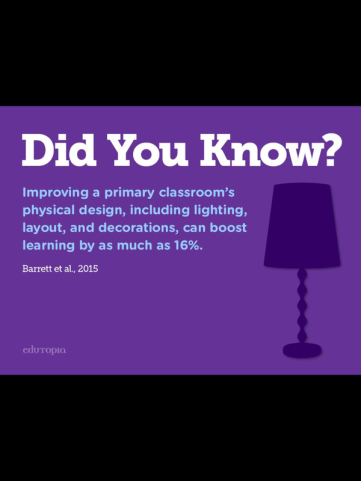Recently, as part of my work, I have been working with schools who have come into some serious money for new building projects. Architects have already been introduced to those schools; however, it was thought wise to actually see other spaces ‘at work’. Further to this, it was also thought worthwhile to look at what researchers and thought leaders offer about designing learning spaces. For a start, Did You Know?????

Planning new physical learning spaces or refurbishing spaces requires the effective use of design thinking principles (Kuratko, Goldsworthy et al. 2012; Razzouk and Shute 2012; Hill 2014). Elements of good design include collaboration and prototyping (Brown 2009); collaborative prototyping (Melles 2012); and user centred input (Brown 2009; Kolko 2010).
Learning Spaces can support, enable and positively impact on the learning experience (Thornburg 2007). The communication and collaboration that comes with iterative nature of prototyping is one characteristic that can assist with generating numerous ideas for new learning spaces in schools (Veloso, Marques et al. 2014). Furthermore, the use of design thinking principles for new building spaces, is currently minimal in most schools, and there is little involvement of students or teachers as ‘future users’ of the space.
Input from students is essential when assessing how the use of learning space can support improved learning outcomes for students (Dugdale 2009). Feedback from students as current users of spaces informs the school about future use of space and the placement of furniture within that space (Woolner, Clark et al. 2012). Such participatory design approaches involving users (students and teachers) can provide a springboard that encourages all learners to become more thoughtful and involved users of their environment (McGregor 2004; Woolner 2009).
There is an argument that physical space is one variable, and that it does not have a direct influence on student learning. However, there is literature which suggests there is a strong relationship between learning and physical spaces (Thornburg 2007; Woolner, Clark et al. 2012). McIntosh in (Howarth 2012) is very definitive when he states,
“Spaces should add value to learning and act as a teaching assistant to learning activities. School buildings need to be viewed as influencers of future practice, not responsive to existing practice of teaching and learning” Ewan McIntosh in (Howarth 2012).
The relationship between learning and physical space is a most important variable which impacts on student learning and can support, stimulate and accelerate learning initiatives grounded in student-centred pedagogy. Innova Design Solutions offer these insights…..

In the main, schools are (still) designed to support an old factory-style paradigm characterised by mandated school hours which revolve around inflexible timetables to deliver traditional learning (Bellanca and Brandt ; OECD 2006; P21 2009; Rotherham and Willingham 2010; AITSL 2012). Such an environment stifles change and creativity and results with ‘more of the same’. Learning spaces of the future need to start with an approach that is ‘design thinking focused’ with resources which will encourage users to think creatively and re-imagine possibilities by taking into account the future use of space.
REFERENCES
AITSL (2012). “Professional Learning Animation.” 12 April 2014, from http://www.youtube.com/watch?v=nRnstWGJwPU.
Bellanca, J. and R. Brandt 21st Century Skills: Rethinking How Students Learn, Solution Tree Press.
Brown, T. (2009). Change by Design: How Thinking Transforms Organizations and Inspires Innovation. New York, Harper Business.
Dugdale, S. (2009). “Space Strategies for the New Learning Landscape.” Educause Review 44(2): 50.
Hill, A. (2014). Using Design Thinking to Develop Personalized Learning Pilots http://www.blendmylearning.com/. 2014.
Howarth, S. (2012). Pedagogy and People over Places and Spaces. A View from the Middle – Thoughts on Learning with Middle School Studnets, http://edusum.edublogs.org/. 2014.
Kolko, J. (2010). “Abductive thinking and sensemaking: The drivers of design synthesis.” Design Issues 26(1): 15-28.
Kuratko, D., M. Goldsworthy, et al. (2012). “The design-thinking process in Innovation acceleration: transforming organizational thinking.” pp.103-123.
McGregor, J. (2004). “Spatiality and the Place of the Material in Schools Pedagogy, Culture and Society,.” 12(3): 347-372.
OECD (2006). Think Scenarios, Rethink Education.
P21 (2009). “21st Century Learning Environments White Paper.”. from http://www.p21.org/documents/le_white_paper-1.pdf
Razzouk, R. and V. Shute (2012). “What is design thinking and why is it important?” Review of Educational Research 82(3): 330-348.
Rotherham, A. and D. Willingham (2010). “21st-Century” Skills. Not New, but a Worthy Challenge.” American Educator 34(1): 17-20.
Thornburg, D. (2007) Campfires in cyberspace: Primordial metaphors for learning in the 21st century. . Thornburg Center for Professional Development. Retrieved from: http://tcpd.org/Thornburg/Handouts/Campfires.pdf
Veloso, L., J. S. Marques, et al. (2014). “Changing education through learning spaces: impacts of the Portuguese school buildings’ renovation programme.” Cambridge Journal of Education 44(3): 401-423.
Woolner, P. (2009). Building Schools for the Future through a participatory design process: exploring the issues and investigating ways forward. BERA Manchester.
Woolner, P., J. Clark, et al. (2012). “Changing spaces: preparing students and teachers for a new learning environment.” Children Youth and Environments 22(1): 52-74.